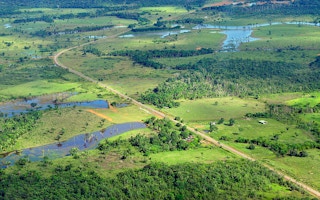The need to slow down destruction of the world’s remaining forests to prevent the planet dangerously overheating has long been acknowledged, but has proved impossible to achieve.
Now a group of scientists has reviewed the state of the forests where the destruction is greatest, in the tropics, and has concluded that the rate of deforestation could be halved in five years – drastically cutting the amount of carbon dioxide being released into the atmosphere.
Their paper in Global Change Biology says Brazil has proved that the rate of deforestation can be cut dramatically, while at the same time allowing an increase in agricultural output. This is significant because Brazil has been cutting down forests faster than any other country in the world.
The scientists say that if Brazil − which has large areas of lawless territory − can slow the destruction, then anyone can.
However, they are not suggesting it will be easy. Short-term financial gains, which do not take into account environmental costs or the long-term interests of the country involved, still dominate, so destruction could increase again.
In fact their fears proved only too real. The latest figures show that deforestation in the Amazon has begun to increase again, by16 per cent so far in 2015, reflecting cuts in funding for the regulatory authorities.
Cuts in funding
Agreements that forests should not be cleared and that poor countries should gain financially from keeping their tropical rainforests have spent decades in negotiation.
Talks first collapsed at the 1992 Earth Summit in Rio de Janeiro, when tropical countries refused to be told to keep their forests standing by rich western countries that had already made money by cutting theirs down.
Saving forests is again one of the priorities of the current Paris climate talks, and a series of new agreements is being announced.
The report says: “Conserving rather than cutting down tropical forests requires shifting economic development away from a dependence on natural resource depletion toward recognition of the dependence of human societies on the natural capital that tropical forests represent, and the goods and services they provide.”
This requires help from beyond national borders, because saving forests is one of the quickest ways to avoid dangerous climate change and is in the self-interest of the international community, the report says.
The sheer scale of deforestation illustrates the point. In 2003, Brazil’s emissions of 1.766 gigatonnes of carbon from deforestation were the equivalent of all of Russia’s emissions from fossil fuels and cement manufacture.
By 2012, Brazil had cut its emissions from deforestation by 80 per cent. Despite this, it still had the highest forest destruction in the world, but that could be cut further if the political will was there.
Second to Brazil is Indonesia, which managed to reduce emissions between 2012 and 2013, but these have since risen again because of disastrous fires. The government is currently clamping down on peatland development to try to reduce this problem.
Indonesia was also one of 15 tropical countries which last year signed the New York Declaration on Forests (NYDF). That includes the goal of halving natural forest loss by 2020.
Significant increases
In addition to the challenge that Indonesia faces in achieving that reduction, the other 14 countries collectively almost doubled their carbon emissions from tropical deforestation − from 12 per cent of the total in 2001 to 23 per cent in 2013. Of these 14 countries, the biggest contributors were the Democratic Republic of Congo and Peru, and there were also significant increases in Vietnam and Liberia. Only Mexico dropped significantly.
The report uses the latest satellite and mapping data to assess the current state of the world’s forests and provide a benchmark so that progress towards the goal of halting forest destruction can be properly measured. The rest is up to us, the report says.
“Market failures and governance failures are the problem,” says Daniel Zarin, the study’s lead author, who is director of programmes at the Climate and Land Use Alliance.
“Forests are cut down because someone profits from selling the wood, or the cattle or crops that are grown on the deforested land, or from speculating in poorly-regulated land markets. But the very real losses that deforestation incurs aren’t counted against those profits.
“And it’s not only carbon emissions. Agricultural regions and urban centres lose the benefits forests provide to the hydrological cycle. And the biodiversity losses alone are incalculable.
“We casually consume products with ingredients grown in faraway lands from which indigenous peoples and other local communities were only recently evicted − or worse − to make way for the chainsaws and the bulldozers that turn forests into vast monocultural fields for commodity manufacture. These are crimes in which we are all complicit.”










